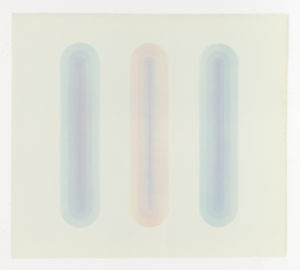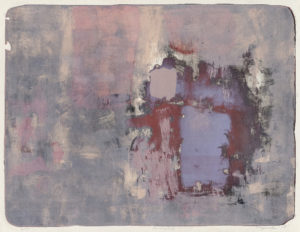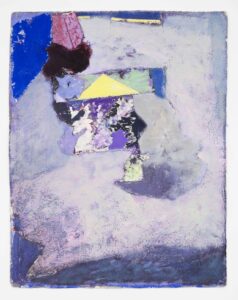Back to List
George Miyasaki (b. 1935, Kalopa, HI – d. 2013, Berkeley, CA) was an American painter and printmaker active in the San Francisco Bay Area arts scene during the mid-to-late twentieth century. Although primarily known for his adeptly and lushly colored Abstract Expressionist work, Miyasaki’s contributions to the movement were largely ignored during his lifetime due to his race. Clement Greenberg and other critics denied the aesthetic influence of East Asian calligraphy and Zen Buddhism on Abstract Expressionism, instead depicting it as the product of exclusively Western traditions.
Born in Hawaii to Japanese parents, Miyasaki grew up in a rural area surrounded by sugar plantations and lived under martial law during World War II. Encouraged by his high school art instructor, he moved to Oakland in the 1950s to study with Nathan Oliveira and Richard Diebenkorn at the California College of Arts & Crafts. He received a BFA in 1957 and an MFA in 1958 before joining the faculty through 1964. He quickly became a key figure in the Bay Area arts community, lecturing at Stanford University and collaborating with Oliveira on two lithographs for Willem de Kooning. In 1964, he became a professor of art practice at the University of California, Berkeley and taught until his retirement in 1994.
Miyasaki gained acclaim as a brilliant colorist in the late 1950s and early 60s for his Abstract Expressionist paintings and prints. Unlike his counterparts of the New York School, Miyasaki was concerned with the spontaneity and randomness of natural creation rather than expressing his own inner psychology. He often drew inspiration from the local landscape, referring to California and the American West in his titles. In the mid-1960s, Miyasaki departed from gestural abstraction and experimented with Pop Art collages before pursuing systematized studies of color and hard-edged shapes in the 1970s, developing his own abstract language that reduced complex organic forms into simple geometric ones. His paintings from the 1980s and 1990s incorporated letters, numbers, checkered patterns, calligraphic brushstrokes and thickly built-up surfaces. He continued to explore this materiality in his late work through the 2000s, combining both expressionistic and hard-edge abstraction with cut-out shapes layered onto the canvas.
Miyasaki also produced over 200 prints throughout his career, a practice that began as an undergraduate student under Leon Goldin and Nathan Oliveira in the mid-1950s. He was deeply interested in the process of printmaking itself, utilizing sculptural layers to produce a final two-dimensional image with remarkable color, depth and texture. In 1958, at age 23, Miyasaki received a purchase award from the Brooklyn Museum for his lithograph included in the National Print Exhibition. In 1961, after working on with two painterly lithographs for de Kooning alongside his former professor Oliveira, he visited the Tamarind Lithography Workshop in Los Angeles and produced editions for Ulfert Wilke, Misch Kohn and June Wayne, alongside new works of his own. He produced fewer prints in the 1980s and 1990s, including a small number of lithographs inspired by the geography of California, but his interests continued to span both painting and printmaking as he investigated new forms of abstraction. In the 2000s he made several series of hard-edge abstract prints, and in 2005, perpetually interested in new methods and textures, he published a tapestry edition that translated his linear forms into weaving.
Miyasaki first became interested in the medium of color lithography while a student in the 1950s. The artist would paint directly on the litho stone before chemically resensitizing it, such that only a ghost of his previous composition remained. Miyasaki would often use this ghost image as a way of layering fully composite images. Starting in the 1960s, Miyasaki began experimenting with the relief process of collagraphy. The artist would college various textured materials onto a wood panel and modify the plate after each print so as to create intricately layered designs. He widened his repertoire in the 1960s and 1970s when he began to use stencils, spray effects, as well as collaged paper in his work. Miyasaki continued to print collagraphs until the year 2011, two years before his death.
Miyasaki has received numerous prestigious awards such as the Henry Ward Ranger Purchase Award (2001), National Academy of Design (1993, 1995), Brooklyn Museum Purchase Award (1958, 2001), National Endowment for the Arts Fellowship (1985, 1980), and Guggenheim Fellowship (1963).
In 2017, Miyasaki was included in Abstract Expressionism: Looking East from the Far West, curated by Theresa Papanikolas at Honolulu Museum of Art, a breakthrough exhibition which sought to re-examine the profound influence of Asian art on Abstract Expressionism. Miyasaki has also been included in solo and group exhibitions at the Yale University Art Gallery, CT (2022); Wallach Art Gallery at Columbia University, NY (2022); Worcester Art Museum, MA (2019); Honolulu Museum of Art, HI (2018); Richmond Art Center, CA (2011); Worth Ryder Gallery at UC Berkeley, CA (2014); de Young Museum, CA (2008); Fort Collins Museum of Contemporary Art, CO (2008); National Academy of Design, NY (2007), among others. In 1993, Mary Ryan Gallery held a solo exhibition of Miyasaki’s prints.
Miyasaki’s work is included in prominent museum collections, including the Art Institute of Chicago, IL; British Museum, UK; Brooklyn Museum, NY; Herbert F. Johnson Museum of Art at Cornell University, NY; Honolulu Academy of Arts, HI; James A. Michener Collection at the University of Texas, Austin, TX; Metropolitan Museum of Art, NY; Museum of Fine Arts, Boston, MA; Museum of Modern Art, NY; National Academy of Design, NY; National Gallery, Washington, D.C.; Oakland Museum of California, CA; Philadelphia Museum of Art, PA; Portland Art Museum, OR; San Diego Museum, CA; San Francisco Art Commission, CA; San Francisco Museum of Modern Art, CA; Walker Art Center, MN; Whitney Museum of American Art, NY; and Worcester Museum of Art, MA.
The estate of George Miyasaki is represented by RYAN LEE.
Born in Hawaii to Japanese parents, Miyasaki grew up in a rural area surrounded by sugar plantations and lived under martial law during World War II. Encouraged by his high school art instructor, he moved to Oakland in the 1950s to study with Nathan Oliveira and Richard Diebenkorn at the California College of Arts & Crafts. He received a BFA in 1957 and an MFA in 1958 before joining the faculty through 1964. He quickly became a key figure in the Bay Area arts community, lecturing at Stanford University and collaborating with Oliveira on two lithographs for Willem de Kooning. In 1964, he became a professor of art practice at the University of California, Berkeley and taught until his retirement in 1994.
Miyasaki gained acclaim as a brilliant colorist in the late 1950s and early 60s for his Abstract Expressionist paintings and prints. Unlike his counterparts of the New York School, Miyasaki was concerned with the spontaneity and randomness of natural creation rather than expressing his own inner psychology. He often drew inspiration from the local landscape, referring to California and the American West in his titles. In the mid-1960s, Miyasaki departed from gestural abstraction and experimented with Pop Art collages before pursuing systematized studies of color and hard-edged shapes in the 1970s, developing his own abstract language that reduced complex organic forms into simple geometric ones. His paintings from the 1980s and 1990s incorporated letters, numbers, checkered patterns, calligraphic brushstrokes and thickly built-up surfaces. He continued to explore this materiality in his late work through the 2000s, combining both expressionistic and hard-edge abstraction with cut-out shapes layered onto the canvas.
Miyasaki also produced over 200 prints throughout his career, a practice that began as an undergraduate student under Leon Goldin and Nathan Oliveira in the mid-1950s. He was deeply interested in the process of printmaking itself, utilizing sculptural layers to produce a final two-dimensional image with remarkable color, depth and texture. In 1958, at age 23, Miyasaki received a purchase award from the Brooklyn Museum for his lithograph included in the National Print Exhibition. In 1961, after working on with two painterly lithographs for de Kooning alongside his former professor Oliveira, he visited the Tamarind Lithography Workshop in Los Angeles and produced editions for Ulfert Wilke, Misch Kohn and June Wayne, alongside new works of his own. He produced fewer prints in the 1980s and 1990s, including a small number of lithographs inspired by the geography of California, but his interests continued to span both painting and printmaking as he investigated new forms of abstraction. In the 2000s he made several series of hard-edge abstract prints, and in 2005, perpetually interested in new methods and textures, he published a tapestry edition that translated his linear forms into weaving.
Miyasaki first became interested in the medium of color lithography while a student in the 1950s. The artist would paint directly on the litho stone before chemically resensitizing it, such that only a ghost of his previous composition remained. Miyasaki would often use this ghost image as a way of layering fully composite images. Starting in the 1960s, Miyasaki began experimenting with the relief process of collagraphy. The artist would college various textured materials onto a wood panel and modify the plate after each print so as to create intricately layered designs. He widened his repertoire in the 1960s and 1970s when he began to use stencils, spray effects, as well as collaged paper in his work. Miyasaki continued to print collagraphs until the year 2011, two years before his death.
Miyasaki has received numerous prestigious awards such as the Henry Ward Ranger Purchase Award (2001), National Academy of Design (1993, 1995), Brooklyn Museum Purchase Award (1958, 2001), National Endowment for the Arts Fellowship (1985, 1980), and Guggenheim Fellowship (1963).
In 2017, Miyasaki was included in Abstract Expressionism: Looking East from the Far West, curated by Theresa Papanikolas at Honolulu Museum of Art, a breakthrough exhibition which sought to re-examine the profound influence of Asian art on Abstract Expressionism. Miyasaki has also been included in solo and group exhibitions at the Yale University Art Gallery, CT (2022); Wallach Art Gallery at Columbia University, NY (2022); Worcester Art Museum, MA (2019); Honolulu Museum of Art, HI (2018); Richmond Art Center, CA (2011); Worth Ryder Gallery at UC Berkeley, CA (2014); de Young Museum, CA (2008); Fort Collins Museum of Contemporary Art, CO (2008); National Academy of Design, NY (2007), among others. In 1993, Mary Ryan Gallery held a solo exhibition of Miyasaki’s prints.
Miyasaki’s work is included in prominent museum collections, including the Art Institute of Chicago, IL; British Museum, UK; Brooklyn Museum, NY; Herbert F. Johnson Museum of Art at Cornell University, NY; Honolulu Academy of Arts, HI; James A. Michener Collection at the University of Texas, Austin, TX; Metropolitan Museum of Art, NY; Museum of Fine Arts, Boston, MA; Museum of Modern Art, NY; National Academy of Design, NY; National Gallery, Washington, D.C.; Oakland Museum of California, CA; Philadelphia Museum of Art, PA; Portland Art Museum, OR; San Diego Museum, CA; San Francisco Art Commission, CA; San Francisco Museum of Modern Art, CA; Walker Art Center, MN; Whitney Museum of American Art, NY; and Worcester Museum of Art, MA.
The estate of George Miyasaki is represented by RYAN LEE.





